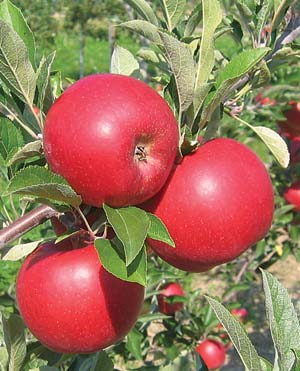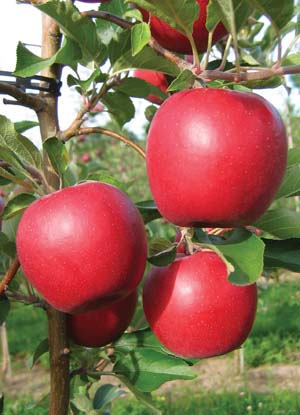Dr. Susan Brown began breeding the new releases in 1996 and screened thousands of seedlings in the search.
Right from the start, Dr. Susan Brown knew what she wanted: An apple that was as delightful to consumers as Honeycrisp but without all its warts. Honeycrisp has problems that make it tough for growers, packers, and retailers to deliver the apple consumers love.
The Cornell University apple breeder set out in 1996, when Honeycrisp was still a new but promising variety, crossing Honeycrisp with other varieties and growing out thousands of seedlings from crosses, looking for that very special thing—the Honeycrisp sweet, juicy crunch, but free from Honeycrisp’s deficiencies.
The first week of May, she announced the release of two new varieties, named New York 1 and New York 2—both crisp, juicy, and grower friendly. Of the two, New York 1 is the most Honeycrisp-like, but later than Honeycrisp, and New York 2 is later still, not as sweet, and more tangy, appealing to a different consumer. New York 1 is a child of Honeycrisp; New York 2 is not.
 New York 1
New York 1
New York 1 produces red apples with sweet, crisp, and juicy flesh like its Honeycrisp parent, Brown said in the announcement. “Its harvest window is from late September to early October, and the apples retain their ripe harvest quality even after storage.
“Some of its best attributes, though, are best appreciated in the orchard. Although Honeycrisp is extremely popular with consumers, it can be challenging to grow because, in some years, fruit defects may leave growers only able to market half their crop. With uniform ripening, good color development, and freedom from storage problems, New York 1 provides premium apples from a reliable tree.”
When they chose Honeycrisp as a parent, they knew they had reasons to be very concerned, Brown said. In describing New York 1, Brown emphasized the ways in which it is not like Honeycrisp.
— It is a reliable annual bearer.
— It may not require multiple pickings.
— It is very red.
— It is free of preharvest drop of ripe fruit.
— The storage disorders that plague the Honeycrisp apple—soft scald, internal browning, carbon dioxide injury—are not problems in regular storage and are much less problematic in CA storage than Honeycrisp.
— It does not have bitter pit.
— Storage life is good in both air and CA storage, although recommended CA regimes will need to be developed in concert with studies by Cornell postharvest researcher Dr. Chris Watkins.
— It is not susceptible to powdery mildew.
— Bruising has not been a problem.
“Both store very well and have excellent shelf life,” she said. “We’re shooting for a storage life that will cover the full marketing year. There’ll be limited quantities at first, of course, but storage will be important.”
Honeycrisp is also noted for attracting wild birds and Japanese beetles. Brown said that particular facet was not evaluated.
 New York 2
New York 2
New York 2 is described as sweet and tart, suited both for baking and fresh use, and boasts the added benefit of higher levels of vitamin C, Brown said.
A cross of Braeburn and another new New York variety Autumn Crisp (formerly NY 674), New York 2 is even more grower friendly than New York 1, Brown said. The goal in breeding this apple was to take two high-in-vitamin C varieties and cross them to develop a superior fresh-eating apple. Consumer response to this apple has been very favorable. New York 2, harvested mid- to late October, is firm, red-skinned, and suited for fresh eating or baking. It is a heavy cropper that will require thinning, she said. Dr. Terence Robinson at Cornell began thinning studies on the new apples this spring.
The parent Autumn Crisp was released only last fall, developed from a cross of Golden Delicious and Monroe. Its shortcoming is its short storage life, Brown said.
Targeted program
Unlike Honeycrisp, which was bred in 1961 at the University of Minnesota but not released until 1991—and then released as a public variety that waited several years for the public to discover—New York 1 came out of a targeted program that involved grower trials, consumer taste tests, and collaborations with other Cornell researchers who studied the tree and the fruit. Its release also came with a plan to make it a variety that will be grown exclusively by growers in New York State, where tax dollars supported the breeding program. And the idea is to do it fast, not wait 20 or more years. The group organizing the growing and marketing program, NYAG LLC (for New York Apple Growers) was formed last year.
These new varieties will generate royalty money that Brown and her Cornell colleagues can use to continue the breeding program. And she has plenty of promising new material in the works. She and her research support specialist Kevin Maloney are evaluating them.
Will these new apples elevate New York as an apple-producing state? Already number two behind Washington but about a fourth as large in production volume, the industry has already been experiencing rejuvenation. New York produced about 30 million bushels last year, its biggest crop in some years, and some New York growers believe the new number may be “the new average,” as New York Apple Growers vice chair Jeffrey Crist called it. Growers have shifted to new varieties and high-density plantings, fresh volume is increasing, processing volume is falling, and overall volume is growing 1.5 percent per year, Crist said.
The grower group that is managing the new varieties will shoot for 400,000 bushels per year in annual production of each of the new varieties.

Leave A Comment